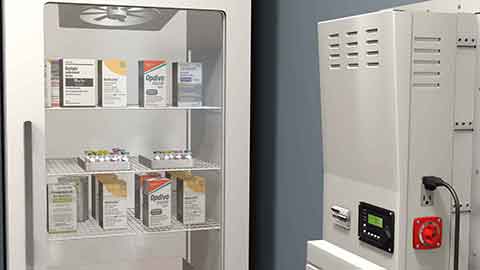How Battery Duty Cycles Affect Battery Life: What Every Healthcare Facility Should Know
In critical settings like pharmacies, hospitals, and laboratories, backup power is more than a convenience — it’s a safety net. And one of the most important yet overlooked factors in battery performance is the battery duty cycle (not to be confused with appliance duty cycle, which is discussed in this article). Understanding it can help facilities managers extend battery life, avoid costly failures, and keep operations running smoothly.
What Is a Duty Cycle?
A duty cycle describes how often and for how long a battery is actively supplying power compared with resting or charging. Think of it as a “work-to-rest” ratio. A battery that only kicks in occasionally during rare outages has a light duty cycle. One that runs frequently or for extended periods is under a heavy duty cycle. This difference significantly affects how long a battery lasts and how reliably it performs.
Why Duty Cycles Matter for Batteries
Every battery is designed with an expected depth of discharge (DoD) and cycle life. The harder you push it — the more frequently and deeply it discharges — the faster it will degrade. Heavy duty cycles increase internal heat, accelerate chemical degradation, and gradually reduce the battery’s capacity to hold a full charge. When backup power is needed, a stressed battery might not deliver the run time you’re counting on. That’s why it’s critical to keep a record of discharge cycles for reference.
Depth of Discharge and Cycle Life
Battery chemistries respond differently to discharge patterns. Sealed lead-acid batteries, widely used in healthcare backup systems, handle shallow discharges well but deteriorate faster if repeatedly drained deeply. Lithium batteries tolerate deeper discharges but still lose capacity faster under intense duty cycles. In general:
- Shallow, infrequent discharges = longer battery life.
- Deep, frequent discharges = shorter battery life.
Managing Duty Cycles in Healthcare Settings
You can do a lot to preserve battery health by managing duty cycles proactively:
- Right-size your system. Oversizing spreads the load across more capacity so batteries work less hard. However, larger systems are usually more expensive, so finding the right size for you is important.
- Test and maintain regularly. Schedule load tests and preventive maintenance to verify performance without pushing batteries too far.
- Use monitoring tools. Battery management systems track charge, discharge, and temperature so you can adjust usage patterns in real time.
- Train staff. Make sure everyone knows how to respond to alarms, monitor status, and handle equipment during an outage.
The Cost of Ignoring Duty Cycles
Failing to manage duty cycles can lead to premature battery failure, unplanned downtime, and expensive emergency replacements. It can also jeopardize patient safety and regulatory compliance. Insurance may cover some loss, but not the damage to reputation or operations.
Bottom Line
Batteries are the backbone of emergency power systems in healthcare facilities. By paying attention to duty cycles — how often and how deeply they’re discharged — you can extend their lifespan, lower costs, and maintain confidence that lifesaving equipment will stay powered during outages.
If you need a new system, or if you have a question about your existing battery backup power solution, feel free to give us a call at 1.800.765.3237 or fill out the request form below. Our knowledgeable emergency power experts will be glad to help you today!


